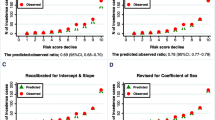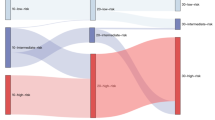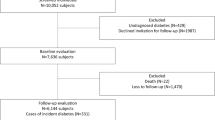Abstract
We validated the transportability of the updated diabetes prediction model from Atherosclerosis Risk in Communities (ARIC) Study, to a Middle Eastern population. We investigated 3,721 participants of the Tehran Lipid and Glucose Study (TLGS) aged ≥20 years, free of diabetes at baseline. They underwent a standard 75gr 2-h post-challenge plasma glucose test that was repeated every 3 years using the same protocol. All the models were tested with respect to discrimination and calibration. We confirm the findings of Kahn et al. (Ann Intern Med 150(11):741–751, 2009) in a middle-aged, Middle Eastern population. We obtained the same predictive discrimination for the ARIC model (C statistic: men 0.790 and women 0.829) as for the TLGS’ own model (men 0.824 and women 0.847) and validated a good calibration for the updated ARIC diabetes prediction model in the TLGS sample. Among men, optimal cut-point was set to the score of 31 where the maximum value of sensitivity (71.6%) plus specificity (75.3%) was achieved. Among women, the optimal point was set to the score of 38 with sensitivity of 67.1% and specificity of 85.0%. The updated ARIC model predicted the individual diabetes risk with a high level of sensitivity and specificity in the TLGS population, which was comparable with that of original sample. More parsimonious model incorporating age, family history of diabetes, waist circumference, pulse rate, and fasting plasma glucose, which were significantly associated with the risk of incident diabetes in the TLGS population, could be equally effective in predicting diabetes.

Similar content being viewed by others
References
Tuomilehto J, Lindstrom J, Eriksson JG, Valle TT, Hamalainen H, Ilanne-Parikka P, Keinanen-Kiukaanniemi S, Laakso M, Louheranta A, Rastas M, Salminen V, Uusitupa M (2001) Prevention of type 2 diabetes mellitus by changes in lifestyle among subjects with impaired glucose tolerance. N Engl J Med 344(18):1343–1350
Pan XR, Li GW, Hu YH, Wang JX, Yang WY, An ZX, Hu ZX, Lin J, Xiao JZ, Cao HB, Liu PA, Jiang XG, Jiang YY, Wang JP, Zheng H, Zhang H, Bennett PH, Howard BV (1997) Effects of diet and exercise in preventing niddm in people with impaired glucose tolerance. The da qing igt and diabetes study. Diabetes Care 20(4):537–544. doi:10.2337/diacare.20.4.537
Knowler WC, Barrett-Connor E, Fowler SE, Hamman RF, Lachin JM, Walker EA, Nathan DM (2002) Reduction in the incidence of type 2 diabetes with lifestyle intervention or metformin. N Engl J Med 346(6):393–403. doi:10.1056/NEJMoa012512346/6/393
Ramachandran A, Snehalatha C, Mary S, Mukesh B, Bhaskar AD, Vijay V (2006) The indian diabetes prevention programme shows that lifestyle modification and metformin prevent type 2 diabetes in asian indian subjects with impaired glucose tolerance (idpp-1). Diabetologia 49(2):289–297. doi:10.1007/s00125-005-0097-z
Chiasson JL, Josse RG, Gomis R, Hanefeld M, Karasik A, Laakso M (2002) Acarbose for prevention of type 2 diabetes mellitus: the stop-niddm randomised trial. Lancet 359(9323):2072–2077. doi:10.1016/S0140-6736(02)08905-5
Harati H, Hadaegh F, Momenan AA, Ghanei L, Bozorgmanesh MR, Ghanbarian A, Mirmiran P, Azizi F (2010) Reduction in incidence of type 2 diabetes by lifestyle intervention in a middle eastern community. Am J Prev Med 38 (6):628-636, e621. doi:10.1016/j.amepre.2010.03.003
Cowie CC, Rust KF, Ford ES, Eberhardt MS, Byrd-Holt DD, Li C, Williams DE, Gregg EW, Bainbridge KE, Saydah SH, Geiss LS (2009) Full accounting of diabetes and pre-diabetes in the U.S. population in 1988–1994 and 2005–2006. Diabetes Care 32(2):287–294. doi:10.2337/dc08-1296
Goyder EC, McNally PG, Drucquer M, Spiers N, Botha JL (1998) Shifting of care for diabetes from secondary to primary care, 1990–5: review of general practices. BMJ 316(7143):1505–1506
Amos AF, McCarty DJ, Zimmet P (1997) The rising global burden of diabetes and its complications: estimates and projections to the year 2010. Diabet Med 14(Suppl 5):S1–S85
Heikes KE, Eddy DM, Arondekar B, Schlessinger L (2008) Diabetes risk calculator. Diabetes Care 31(5):1040–1045. doi:10.2337/dc07-1150
Bozorgmanesh MR, Hadaegh F, Padyab M, Mehrabi Y, Azizi F (2008) Temporal changes in anthropometric parameters and lipid profile according to body mass index among an adult iranian urban population. Ann Nutr Metab 53(1):13–22
Hadaegh F, Bozorgmanesh MR, Ghasemi A, Harati H, Saadat N, Azizi F (2008) High prevalence of undiagnosed diabetes and abnormal glucose tolerance in the iranian urban population: Tehran lipid and glucose study. BMC public health 8:176. doi:10.1186/1471-2458-8-176
Esteghamati A, Gouya MM, Abbasi M, Delavari A, Alikhani S, Alaedini F, Safaie A, Forouzanfar M, Gregg EW (2008) Prevalence of diabetes and impaired fasting glucose in the adult population of iran: National survey of risk factors for non-communicable diseases of iran. Diabetes Care 31(1):96–98. doi:10.2337/dc07-0959
Lindstrom J, Tuomilehto J (2003) The diabetes risk score: a practical tool to predict type 2 diabetes risk. Diabetes Care 26(3):725–731. doi:10.2337/diacare.26.3.725
Stern MP, Williams K, Haffner SM (2002) Identification of persons at high risk for type 2 diabetes mellitus: do we need the oral glucose tolerance test? Ann Intern Med 136(8):575–581
McNeely MJ, Boyko EJ, Leonetti DL, Kahn SE, Fujimoto WY (2003) Comparison of a clinical model, the oral glucose tolerance test, and fasting glucose for prediction of type 2 diabetes risk in japanese americans. Diabetes Care 26(3):758–763
Group TDPPR (2003) Costs associated with the primary prevention of type 2 diabetes mellitus in the diabetes prevention program. Diabetes Care 26(1):36–47. doi:10.2337/diacare.26.1.36
Herman WH, Hoerger TJ, Brandle M, Hicks K, Sorensen S, Zhang P, Hamman RF, Ackermann RT, Engelgau MM, Ratner RE (2005) The cost-effectiveness of lifestyle modification or metformin in preventing type 2 diabetes in adults with impaired glucose tolerance. Ann Intern Med 142(5):323–332
Eddy DM, Schlessinger L, Kahn R (2005) Clinical outcomes and cost-effectiveness of strategies for managing people at high risk for diabetes. Ann Intern Med 143(4):251–264
Abdul-Ghani MA, Williams K, DeFronzo RA, Stern M (2007) What is the best predictor of future type 2 diabetes? Diabetes Care 30(6):1544–1548. doi:10.2337/dc06-1331
Aekplakorn W, Bunnag P, Woodward M, Sritara P, Cheepudomwit S, Yamwong S, Yipintsoi T, Rajatanavin R (2006) A risk score for predicting incident diabetes in the thai population. Diabetes Care 29(8):1872–1877
Schmidt MI, Duncan BB, Bang H, Pankow JS, Ballantyne CM, Golden SH, Folsom AR, Chambless LE (2005) Identifying individuals at high risk for diabetes: the atherosclerosis risk in communities study. Diabetes Care 28(8):2013–2018
Schulze MB, Hoffmann K, Boeing H, Linseisen J, Rohrmann S, Mohlig M, Pfeiffer AF, Spranger J, Thamer C, Haring HU, Fritsche A, Joost HG (2007) An accurate risk score based on anthropometric, dietary, and lifestyle factors to predict the development of type 2 diabetes. Diabetes Care 30(3):510–515
Schulze MB, Weikert C, Pischon T, Bergmann MM, Al-Hasani H, Schleicher E, Fritsche A, Häring H-U, Boeing H, Joost H-G (2009) Use of multiple metabolic and genetic markers to improve the prediction of type 2 diabetes: the epic-potsdam study. Diabetes Care 32(11):2116–2119. doi:10.2337/dc09-0197
Hippisley-Cox J, Coupland C, Robson J, Sheikh A, Brindle P (2009) Predicting risk of type 2 diabetes in england and wales: prospective derivation and validation of qdscore. BMJ 338:b880
Kahn HS, Cheng YJ, Thompson TJ, Imperatore G, Gregg EW (2009) Two risk-scoring systems for predicting incident diabetes mellitus in U.S. Adults age 45 to 64 years. Ann Intern Med 150(11):741–751
Rahman M, Simmons RK, Harding AH, Wareham NJ, Griffin SJ (2008) A simple risk score identifies individuals at high risk of developing type 2 diabetes: a prospective cohort study. Fam Pract 25(3):191–196
Wilson PW, Meigs JB, Sullivan L, Fox CS, Nathan DM, D’Agostino RB Sr (2007) Prediction of incident diabetes mellitus in middle-aged adults: the framingham offspring study. Arch Intern Med 167(10):1068–1074
Chien K, Cai T, Hsu H, Su T, Chang W, Chen M, Lee Y, Hu FB (2009) A prediction model for type 2 diabetes risk among chinese people. Diabetologia 52(3):443–450. doi:10.1007/s00125-008-1232-4
Kolberg JA, Jorgensen T, Gerwien RW, Hamren S, McKenna MP, Moler E, Rowe MW, Urdea MS, Xu XM, Hansen T, Pedersen O, Borch-Johnsen K (2009) Development of a type 2 diabetes risk model from a panel of serum biomarkers from the inter99 cohort. Diabetes Care 32(7):1207–1212. doi:10.2337/dc08-1935
Glumer C, Vistisen D, Borch-Johnsen K, Colagiuri S (2006) Risk scores for type 2 diabetes can be applied in some populations but not all. Diabetes Care 29(2):410–414. doi:10.2337/diacare.29.02.06.dc05-0945
Azizi F, Ghanbarian A, Momenan AA, Hadaegh F, Mirmiran P, Hedayati M, Mehrabi Y, Zahedi-Asl S (2009) Prevention of non-communicable disease in a population in nutrition transition: Tehran lipid and glucose study phase ii. Trials 10(1):5. doi:10.1186/1745-6215-10-5
Hadaegh F, Zabetian A, Harati H, Azizi F (2006) Waist/height ratio as a better predictor of type 2 diabetes compared to body mass index in tehranian adult men–a 3.6-year prospective study. Exp Clin Endocrinol Diabetes 114(6):310–315. doi:10.1055/s-2006-924123
Genuth S, Alberti KG, Bennett P, Buse J, Defronzo R, Kahn R, Kitzmiller J, Knowler WC, Lebovitz H, Lernmark A, Nathan D, Palmer J, Rizza R, Saudek C, Shaw J, Steffes M, Stern M, Tuomilehto J, Zimmet P (2003) Follow-up report on the diagnosis of diabetes mellitus. Diabetes Care 26(11):3160–3167
Sullivan LM, Massaro JM, D’Agostino RB Sr (2004) Presentation of multivariate data for clinical use: The framingham study risk score functions. Stat Med 23(10):1631–1660. doi:10.1002/sim.1742
Sadr S, Namayandeh S, Moadares M, Rafiei M (2009) Serum uric acid levels and its association with cardiovascular risk factors. Iran J Public Health 38(1):53–59
Hanley JA, McNeil BJ (1982) The meaning and use of the area under a receiver operating characteristic (roc) curve. Radiology 143(1):29–36
D’Agostino RB, Nam BH (2004) Evaluation of the performance of survival analysis models: discrimination and calibration measures. In: Balakrishnan N, Rao CR (eds) Handbook of statistics, survival methods, vol 23. Elsevier, Amsterdam, p 1. doi:10.16/S0169-7161(03)23001-7
Hosmer DW, Lemeshow S (2000) Applied logistic regression. Wiley, Interscience
Hosmer DW, Lemeshow S, May S (2008) Applied survival analysis: regression modeling of time-to-event data, 2nd edn. Wiley-Interscience, Hoboken, NJ
Grønnesby JK, Borgan Ø (1996) A method for checking regression models in survival analysis based on the risk score. Lifetime Data Anal 2(4):315–328
May S, Hosmer DW (1998) A simplified method of calculating an overall goodness-of-fit test for the cox proportional hazards model. Lifetime Data Anal 4(2):109–120
Akaike H (1974) A new look at the statistical model identification. IEEE Trans Automat Contr AC 19:716–723
Schwarz G (1978) Estimating the dimension of a model. Ann Stat 6:461–464
Tirosh A, Rudich A, Shochat T, Tekes-Manova D, Israeli E, Henkin Y, Kochba I, Shai I (2007) Changes in triglyceride levels and risk for coronary heart disease in young men. Ann Intern Med 147(6):377–385
Wells S, Kerr A, Eadie S, Wiltshire C, Jackson R (2010) ‘Your heart forecast’: a new approach for describing and communicating cardiovascular risk? Heart 96(9):708–713. doi:10.1136/hrt.2009.191320
Bozorgmanesh M, Hadaegh F, Ghaffari S, Harati H, Azizi F (2010) A simple risk score effectively predicted type 2 diabetes in iranian adult population: population-based cohort study. Eur J Public Health. doi:10.1093/eurpub/ckq074
Association AD (2010) Standards of medical care in diabetes—2010. Diabetes Care 33(Suppl 1):S11–S61. doi:10.2337/dc10-S011
Haim M, Benderly M, Brunner D, Behar S, Graff E, Reicher-Reiss H, Goldbourt U (1999) Elevated serum triglyceride levels and long-term mortality in patients with coronary heart disease: the bezafibrate infarction prevention (bip) registry. Circulation 100(5):475–482
Herman WH (2009) Predicting risk for diabetes: choosing (or building) the right model. Ann Intern Med 150(11):812–814. doi:10.1059/0003-4819-150-11-200906020-00010
Mainous AG III, Diaz VA, Everett CJ (2007) Assessing risk for development of diabetes in young adults. Ann Fam Med 5(5):425–429. doi:10.1370/afm.705
von Eckardstein A, Schulte H, Assmann G (2000) Risk for diabetes mellitus in middle-aged Caucasian male participants of the procam study: implications for the definition of impaired fasting glucose by the American diabetes association. Prospective cardiovascular Munster. J Clin Endocrinol Metab 85(9):3101–3108
Meigs JB, Shrader P, Sullivan LM, McAteer JB, Fox CS, Dupuis J, Manning AK, Florez JC, Wilson PWF, D’Agostino RB Sr, Cupples LA (2008) Genotype score in addition to common risk factors for prediction of type 2 diabetes. N Engl J Med 359(21):2208–2219. doi:10.1056/NEJMoa0804742
Bozorgmanesh M, Hadaegh F, Zabetian A, Azizi F (2010) San antonio heart study diabetes prediction model applicable to a middle eastern population? Tehran glucose and lipid study. Int J Public Health. doi:10.1007/s00038-010-0130-y
Ealovega MW, Tabaei BP, Brandle M, Burke R, Herman WH (2004) Opportunistic screening for diabetes in routine clinical practice. Diabetes Care 27(1):9–12. doi:10.2337/diacare.27.1.9
Engelgau MM, Narayan KM, Herman WH (2000) Screening for type 2 diabetes. Diabetes Care 23(10):1563–1580
Johnson SL, Tabaei BP, Herman WH (2005) The efficacy and cost of alternative strategies for systematic screening for type 2 diabetes in the U.S. Population 45–74 years of age. Diabetes Care 28(2):307–311
Cook NR (2007) Use and misuse of the receiver operating characteristic curve in risk prediction. Circulation 115(7):928–935. doi:10.1161/CIRCULATIONAHA.106.672402
Acknowledgments
This study was supported by grant no. 121 from the National Research Council of the Islamic Republic of Iran.
Author information
Authors and Affiliations
Corresponding author
Rights and permissions
About this article
Cite this article
Bozorgmanesh, M., Hadaegh, F. & Azizi, F. Transportability of the updated diabetes prediction model from Atherosclerosis Risk in Communities Study to a Middle Eastern adult population: community-based cohort study. Acta Diabetol 50, 175–181 (2013). https://doi.org/10.1007/s00592-010-0241-1
Received:
Accepted:
Published:
Issue Date:
DOI: https://doi.org/10.1007/s00592-010-0241-1




